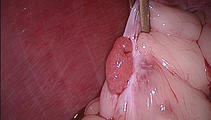Laparoscopic Spay (LUV spay)

is a technique for neutering female cats and dogs. Performed through one to three small incisions in the abdomen rather than a large incision, it offers a less painful, safer and faster healing alternative to traditional spays. Other terms commonly used for spay throughout the world are ovaeriectomy, ovariohysterectomy, sterilization, sterilisation, desexing, neuter, castrastion and spey. In developing parts of the world, the technique can be employed for low-cost control of stray dog populations, since the dogs do not need to be housed and fed for very long after surgery and before release.
TRADITIONAL SPAY
- 5 – 10 cm incision
- Pain & bruising from blindly tearing ovarian ligament
- Post-operative pain
- Open surgical procedure
- Inpatient surgery requires overnight stay
LAPARASCOPIC SPAY
- 1 – 3 Tiny Holes
- Reduced pain due to precise surgical cuts
- Up to 65% less post-operative pain
- Minimally invasive technique reduces chance of infection
- Outpatient surgery allows your pet to recover at home
LAPAROSCOPIC SPAYS
Because your pet deserves 65% less pain
A study published in the 2005 Journal of the Veterinary Medical Association concluded laparoscopic spays caused less surgical stress and up to 65% less postoperative pain than a traditional “open” surgical spay.
In a traditional spay a 5 to 10 cm incision is made in the abdomen through which the ovarian ligament is blindly torn from the abdominal wall. This tearing causes bruising to your pets abdominal wall and postoperative pain. In most cases your pet will be required to stay overnight. The incision takes up to two weeks to heal, with ample opportunity for infection or for her to tear open the stitches.
By performing the surgery laparoscopically (a minimally invasive technique for viewing the internal structures of the abdomen), the procedure is performed through one to three small incisions in the abdomen, 0.32 to 1.27cm in length depending on the size of your pet. A laparoscope (camera) magnifies the internal structures of the abdomen on a TV monitor, allowing for greater surgical precision and fewer complications. The magnified view of the ovarian ligament allows the doctor to carefully cut and cauterize it rather than blindly tearing it, as in a traditional spay; this eliminates the pain your pet would experience from bruising caused by tearing the ligament. The small incisions are sutured and she will usually be sent home the same day. With a laparoscopic spay, your dog will experience less trauma, heal faster and experience up to 65% less post-operative pain.
In cases of larger breed, deep chested dogs, gastropexy can be performed at the time of the lap spay to prevent life-threatening gastric torsion (bloat).
Please contact us today to make an appointment to discuss this Veterinary Endoscopy procedure with one of our New Hope Animal Hospital doctors in Cedar Park TX.
